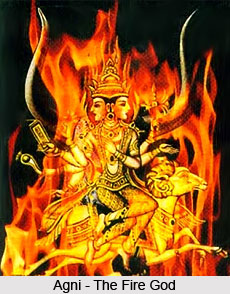 The Fire God in Agni Purana has described the rite of Shiva-Shanti and the Mantra which accompanies the rite is known as Aghorakalpa. It has been said that the Shiva-Shanti rite absolves even the killer of a Brahmana, of all sins incidental to such an act, is the abode of all the three sorts of penitential successes, and is the healer of all distempers that afflict the human flesh or mind. Phenomena that portend evil are subsided under the pacifying influence of the ceremony, whether they appear in the sky or heaven, or are brought about by the direct intervention of the gods. The rite is the best atonement for all sins, is the most powerful agent in giving a better turn to one`s fortune, and is the best dispeller of all gloom that hangs over the mind of a man.
The Fire God in Agni Purana has described the rite of Shiva-Shanti and the Mantra which accompanies the rite is known as Aghorakalpa. It has been said that the Shiva-Shanti rite absolves even the killer of a Brahmana, of all sins incidental to such an act, is the abode of all the three sorts of penitential successes, and is the healer of all distempers that afflict the human flesh or mind. Phenomena that portend evil are subsided under the pacifying influence of the ceremony, whether they appear in the sky or heaven, or are brought about by the direct intervention of the gods. The rite is the best atonement for all sins, is the most powerful agent in giving a better turn to one`s fortune, and is the best dispeller of all gloom that hangs over the mind of a man.
Agni Purana says that the rite of Nyasa, in connection with the ceremony, should be performed, by mentally assigning the different parts of one`s body to the Eknetra manifestation of the god, after which the votary, should meditate upon the divine self of the five-faced one. The faces of the god, should be contemplated white, in all religious ceremonies, undertaken with a view to confer peace and prosperity on a person, red or yellow in charms, brown in acts where the object would be stupefaction of one`s intellectual faculties or organic functions, while they should be imagined dark black in fatal or maddening incantations. The faces should be imagined as burning with a tawny or flaming hue in incantations of oblivion, or of attracting the mind of a man towards one`s self.
It is said that the Mantra consisting of thirty-two letters, should be first worshipped, and then repeated a thirty lakhs of time. Libations of clarified cow-butter, and numbering a tenth part of the latter, should be poured on the fire. Such libations consisting of the essence of gum-resin, and poured on the fire as stated in the preceding line, convert a novice into an adept in the spiritual mysteries, and help him in attaining, whatever he sets his mind upon. The Aghora-Mantra grants both worldly good and salvation of the soul, and there is no other Mantra which can vie with it in that respect. By repeating it, a man, who is not an ascetic, acquires the fullest merit of asceticism, and a man who has never gone through the vow of religious ablution, becomes a Snataka (a religious bather) in every acceptance of the term. The Aghora-, and the Aghorastra-, Mantras are the two kings of the Mantras. The rites of Homa, Japa, and worship in connection with the Mantra, if duly performed, would enable a man to annihilate his enemy`s army in battle.
The rite of Rudra-Shanti is also a component of the rite of Shiva-Shanti. It has been said that under the influence of this rite barren women become mothers, malignant planets become friendly, and diseases become scarce under the benign influence of the present ceremony, famine forsakes a country and evil dreams never oppress the sleep of its inmates. The rite should be undertaken when evil times would be prophesied by the unnatural blossoming of trees or by inauspicious dreams in the night.
In the rite of Shiva-Shanti as mentioned by Lord Agni it has been said that all the five manifestations of Rudra should be worshipped and also the god Maheshwara with his consort Uma should be worshipped.
Finally it has been said that the ceremony should be closed with the rites of necessary Homas and Japas, whereby all desires would be fulfilled, and all diseases incidental to the malign influences of planets, would be cured.



















